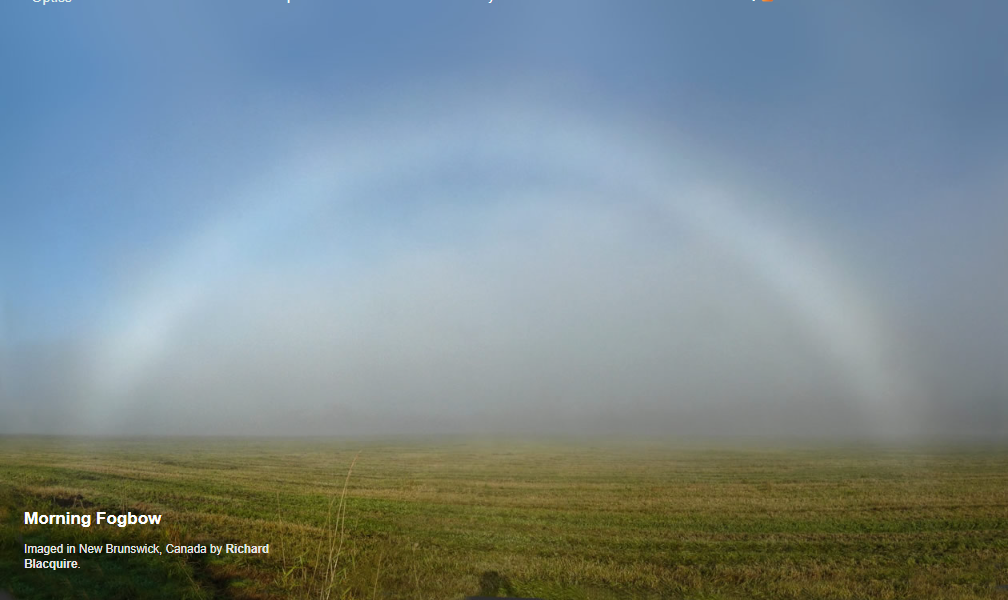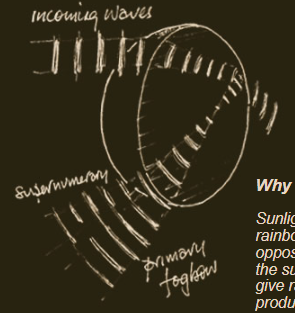Morning Fogbow - OPOD
Morning Fogbow: A Spectacular Atmospheric Phenomenon
Fogbows, also known as white rainbows or ghost rainbows, are a captivating atmospheric phenomenon that occurs when sunlight interacts with fog or mist. While they may not be as commonly observed as rainbows, fogbows possess their own unique charm. In this article, we will delve into the mesmerizing world of morning fogbows and explore the science behind their formation.
The Enchanting Encounter with a Morning Fogbow
Imagine waking up to a serene morning where a dense fog blankets the landscape. As the sun gradually rises, its warm rays begin to pierce through the fog, creating an ethereal ambiance. It is during this magical moment that a morning fogbow may grace the sky, captivating the observer with its elusive beauty.
One such encounter was experienced by Richard Blacquire in New Brunswick, Canada. As he stood at a vantage point overlooking an old field above the Hampton marsh, he witnessed the birth of a fogbow. The fog was not sufficiently high to display the complete arc, but it was still a sight to behold. Blacquire, fascinated by this phenomenon, seized the opportunity to capture numerous photographs, documenting the captivating dance of light and mist.
A Closer Look at a Morning Fogbow
Blacquire's photograph reveals intriguing details about the morning fogbow he encountered. The outer rim of the fogbow exhibits a hint of red, while the inner rim possibly displays a touch of blue. Inside the fogbow, there is a characteristic dark band, representing the gap between the main fogbow and its first supernumerary fringe. Interestingly, Blacquire's shadow can be seen at the center of the bow, aligning with the antisolar point.
The Science Behind Fogbows
To understand why fogbows form, we must turn to the principles that govern the creation of rainbows. Both rainbows and fogbows are products of sunlight interacting with water droplets. However, the key difference lies in the size of the droplets involved. While rainbows are formed by larger raindrops measuring between 1 and 5 millimeters in diameter, fogbows arise from smaller fog droplets ranging from 0.01 to 0.2 millimeters in diameter.
The relatively small size of fog droplets compared to the wavelength of visible light (10-100 times larger) leads to significant wave effects. When sunlight enters a fog droplet, it undergoes scattering in multiple directions, resulting in overlapping and interfering outgoing scattered waves. This phenomenon, known as diffraction, gives rise to a diffuse circle of light rather than the well-defined arch of a rainbow.
The Evolution of Fog Droplets
In Blacquire's photograph, the lack of clear supernumerary fringes indicates that the fog was old and had evolved into droplets with a wide distribution of sizes. As fog persists, the smaller droplets coalesce and grow, eventually reaching sizes that can produce more distinct supernumerary fringes. These fringes manifest as faint bands of colors on the inner edge of rainbows and fogbows.
The Enigmatic Appeal of Morning Fogbows
Morning fogbows possess an enigmatic appeal that captures the imagination of those fortunate enough to witness them. Their ethereal beauty and the interplay between light and mist create a mesmerizing visual spectacle. While they may not be as vibrant or well-defined as rainbows, their subtle hues and delicate presence make them a unique and captivating atmospheric phenomenon.
Conclusion
Morning fogbows offer a glimpse into the enchanting world of atmospheric optics. These ethereal phenomena arise from the interaction between sunlight and small fog droplets, resulting in a diffuse circle of light known as a fogbow. With their subtle colors and delicate appearance, morning fogbows provide a captivating experience for those fortunate enough to witness them. So, the next time you find yourself in a misty morning, keep your eyes peeled for the elusive charm of a morning fogbow.

Morning Fogbow
Imaged in New Brunswick, Canada by Richard Blacquire.
"The morning was cool and calm and a fairly dense fog lay in the Kennebecasis River Valley. By 8:30 the sun was beginning to burn through it. I drove to a vantage point so the sun was behind me and I was looking down onto an old field above the Hampton marsh. Sure enough, a fogbow had formed. Not a complete bow - the fog was not sufficiently high to show the top of the arc. Even so, I took many pictures.
Then, down the road to another elevation looking down on a farm field, a better bow this time. The fog was higher and the top of the bow was visible. Many more pictures."
This picture is from two images stitched together by PTgui and with very little further adjustment.
©Richard Blacquire, shown with permission

This fogbow shows a hint of red on its outer rim and perhaps some blue on the inner one. There is a characteristic dark band inside representing the gap between the main fogbow and its first supernumerary fringe. Notice Richard's shadow at the bow's centre, the antisolar point.
The bow was made by quite small water droplets and the lack of clear supernumeraries shows that the fog was old and had evolved into droplets with a wide distribution of sizes.
Why a fogbow?
Sunlight making a fogbow follows the same recipe as that for a rainbow. Light enters a water sphere, reflects once from the opposite side and leaves in several directions almost back towards the sun. The difference is that large (1-5mm diameter) raindrops give rainbows while small fog droplets (0.01 - 0.2mm diameter) produce fogbows.
The smaller droplets are only 10-100 times the size of wavelengths of visible light and wave effects are therefore significant. At each surface the light waves are scattered in many directions and these outgoing scattered waves overlap and interfere - in other parlance they are diffracted. The result is a broad and diffuse circle of light rather than the sharper rainbow. However, rainbows themselves are not innocent of diffraction effects - witness their supernumerary fringes.
Note: this article has been automatically converted from the old site and may not appear as intended. You can find the original article here.
Reference Atmospheric Optics
If you use any of the definitions, information, or data presented on Atmospheric Optics, please copy the link or reference below to properly credit us as the reference source. Thank you!
-
<a href="https://atoptics.co.uk/blog/morning-fogbow-opod/">Morning Fogbow - OPOD</a>
-
"Morning Fogbow - OPOD". Atmospheric Optics. Accessed on November 26, 2024. https://atoptics.co.uk/blog/morning-fogbow-opod/.
-
"Morning Fogbow - OPOD". Atmospheric Optics, https://atoptics.co.uk/blog/morning-fogbow-opod/. Accessed 26 November, 2024
-
Morning Fogbow - OPOD. Atmospheric Optics. Retrieved from https://atoptics.co.uk/blog/morning-fogbow-opod/.